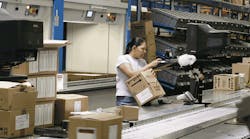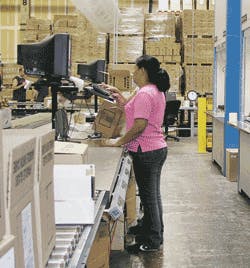Manufacturers that supply a wide range of products must also manage a wide range of product profiles, from slow movers to fast movers, small items to large. Material handling approaches must also vary if these manufacturers are to maintain efficiency. Flow rack may be fine for fast moving items, but everyone's inventory ranges from fast to slow movers. So matching the right technology for the right need becomes critical for every manufacturer.
Even Gucci Group, makers of luxury goods that image-conscious consumers covet, offers items that can be considered slower movers. That's why a few years ago, as the company's growth was accelerating and it decided to consolidate 200,000 square feet of operations into its existing 100,000 square foot facility, it had to implement a material handling scheme allowing for these differences in product demand. Of Gucci's more than 3,800 active SKUs, 25% were classified as very active, and therefore moved into pick-to-light flow rack.
For the rest of their lines, however, particularly perfumes, the company's space constraints dictated a different approach. This took the form of three vertical lift modules (VLMs), from KardexRemstar (www.kardex-remstar.com). A VLM is an enclosed series of trays in a column in both the front and back with an inserter/extractor device running in the center. With a push of a button, scan of a barcode or click of a mouse, a tray is extracted or placed back in storage in the smallest space possible.
At Gucci, VLM orders are picked in batches of 10. The operator scans the barcode on the shipping container label and the position on the batch station. When the batch is ready to be picked, VLM trays are automatically delivered to a pick window. Indicators tell operators which SKU and what quantity to pick. Once the batch is complete, the order pickers push the cartons onto the take-away conveyor, which delivers the cartons to the next zone or to the weighing and shipping department.
Monthly slotting analysis balances the system based on SKU order velocity and physical size.
By reducing the walking distance for associates retrieving items during order fulfillment, Gucci was able to reduce labor costs and increase productivity by 40% while saving up to 80% of otherwise wasted floor space. The three VLMs provide approximately 1,800 feet of accessible storage space in a 210 square foot footprint. The company calculated an 18-month return on investment for the VLMs based exclusively on labor savings. That was based on an additional 40% increase in productivity, although on some days that goes up to 100%.
A key lesson learned since Gucci implemented its VLMs is that everything changes. Although Gucci has since divested itself of the perfume business that kept these VLMs running, the VLMs have been repurposed for Gucci's other slow- to medium-moving items. So, as the system integrator on this job sees it, the VLMs are still paying back.
"The benefits of VLMs—space utilization, productivity and accuracy—aren't locked into one product," says Donald Cronin, president and CEO of Alternative Technologies, Inc. "When we did the original design, the number of temps they had to bring in during the holidays was huge, and we drove it down to the point where the VLMs paid for themselves in four to five months—and they continue to provide a positive cash flow now that they've repurposed them."
Not Just for High-End Products
These are lessons that resonate with the smaller competitors of big box retailers like Amazon and Walmart who are fighting for their piece of the lower-end consumer goods market.
"E-commerce is a big driver for VLMs because these companies need to maintain a wide range of SKUs to remain competitive," says Ed Romaine, chief marketing officer for Integrated Systems Design (ISD)-Andersen Material Handling (www.ISDDD.com). "When you put items in a VLM's tray it can automatically scan them and put them away in the least amount of space required so each unit is optimized. And besides reduction in labor there's also reduction in shrinkage. When you have items on shelving things can get ‘misplaced.' With a VLM you have the ability to know exactly who accesses items. Access can also be restricted to specific trays."
Romaine says the reliability of VLMs as part of a material handling system has enabled his company to offer a performance guarantee.
"When we put in a system we have a program where we can look at the total performance and set benchmarks and guarantee those benchmarks for the customer, whether it is labor, throughput, time or budget," he says. "You start with a very clean scope of what the customer is looking for. You then design the system, incorporating VLMs and any other equipment. We define the scope, the system's objectives, and then we figure how to design the system to reach those objectives. We simulate it to demonstrate the throughput. This offers validation."
And what if by some chance they have to honor their guarantee?
"Worst case scenario is we will take back the equipment and it won't cost the customer, but this has never happened," he says. "When you take the time to do the system right you can hit the numbers. That's not the problem. The biggest risk is significant changes to a customer's business mid-implementation that require changes in design and deliverables. But that is where proper definition and execution allows us to make and fulfill our guarantee."
VLMs as System Components
Despite Gucci's success in repurposing its three VLMs, defining a VLM's role in a system is still important, whether the application calls for a single VLM or a series of them. According to Thompson Brockmann, principal with the supply chain consulting firm Tompkins International (www.tompkinsinc.com), that definition helps ensure successful system integration.
"In the event of multiple VLMs, the strategy can include a decision to pick and pass the order containers between modules or to extract the pick-from container to a central consolidation station," Brockmann explains. As for the staffing issue, VLMs used in an array will have one person operating multiple VLMs. The operator simply picks from each unit as the pick light indicates. The walking distance of one operator walking up and down multiple VLMs is still fractional to the time spent making picks from the same number of SKUs in the equivalent amount of flow rack and shelving.
As their customers' businesses change, VLM manufacturers are improving their ability to deliver an effective automated goods delivery system that handles heavy, slower and medium moving items while taking up a minimal footprint. Today these systems can provide multiple pickup and delivery stations at different elevations, further improving their flexibility within an integrated solution. The key is to correctly evaluate and integrate a VLM into your fulfillment profile and to consider how that profile could change in the near future.




